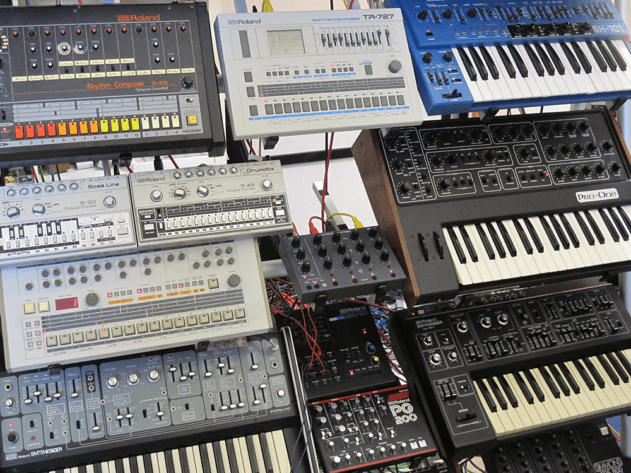Hardware Drum Machines
In this DAW-dominated age it may feel like reverting to hardware is only for the wealthy or misguided – after all, isn’t digital hardware just a computer with dedicated knobs and buttons, running some specialist software? That may be correct in many respects, but in terms of programming beats, the hands-on appeal of a hardware interface can have a lot going for it, even if it’s just triggering samples.
The classic example of this is the Roland x0x system, which is now being used on the company’s latest AIRA TR-8 box, among countless others. The x0x sequencer is simple: it’s basically just a bunch of buttons (usually 16) with lights. Select a sound, press the relevant button to trigger the sound at that particular beat step… and that’s it. For whatever reason, it’s a process which makes things quick, fun and much different to using a mouse. Korg’s Volca Beats uses a similar system and, like their Electribe units of yore, allows you to record your parameter knob twiddling as well. It’s a surprisingly inspiring way to generate new ideas which you might not think of when using a DAW or other controllers.
In fact, you don’t have to pay silly money to grab a hardware drum machine (although if you’ve got the cash to spare we’d definitely recommend exploring the higher reaches of our recent guide to some of the best hardware units on the market). Older digital units can be bought for under £50, and even if they don’t have the cachet or sonic character of a DMX or LinnDrum they can be great for adding extra flavour.


12.48 PM
best mag in the net!
06.29 PM
Good Job Bruce!
05.12 AM
Superb
11.22 AM
meh, equalizing is much more important than compression
12.16 PM
The tuning of the drums is also very important. Not all percussion is unpitched, therefore it might be a good idea to tune drums either to the tonic, fifth, or whatever scale degree the drum section accompanies. Great tips, tho.
02.23 PM
Another thing you can try: Use a Vocoder on your drums!
02.25 PM
Leo – great point, and not just for pitched elements either. Pitching anything from kicks to claps to hi-hats up or down a step or two can have a dramatic impact on the overall sound of a beat.
Check out our guide to the basics of drum tuning here: http://www.attackmagazine.com/technique/walkthroughs/how-to-tune-kick-snare-tom-drum-samples/
11.32 AM
Great tips! You can also drive tracks and groups trough guitarpedals. Adding a hint of distortion to beats sound pretty amazing many times. No need to add it much, a bit of nice harmonic distortion you don’t even notice brings nice crispy attack and richer harmonics. Mooer pedals for example are pretty cheap but effectice. Here some kick drum / various pedals examples http://thegearfiend.com
Would be nice to see an article about how different pedals work with full beats;)
09.02 PM
Second that article idea from Hannu!
Just use everything you have in your toolkit. I begin with pitching sounds, to see if they can fit better to the mood. EQing the shit out ouf your drums, you don’t need or want (which depends on the overall sound you’re looking for actually ). Then you might compress your drums to beef ’em up if your tracks need it, give specific sounds some room and reverb (I do it with sends) and then do some bus compression. Don’t overdo it and the result should be a drum sound you can definitely use. Tweak the rest later in the Mixing, because you will then have a stronger opinion on the overall sound you want.
I think a big problem is a missing idea of the “big picture” in the first place. It’s easy to trick yourself into twiddle your drums and bass and all that difficult too long, while you don’t have any idea about how you want them to sound when it’s done. This idea can be there from beginning or can build up while you compose and arrange the track – just be sure you don’t tweak for hours without thinking of your whole track and how it should sound in the end. It’s easy to lose hours when not thinking the way, I did it – and still it’s happening too often.
11.43 PM
it’s easy to mix and compress just drums and make them sound beefy and loud like in your examples. in fact, there are tons of garbage tech house sample packs with pre-compressed drum grooves that can serve the exact same purpose as having loops like these
how about you throw in some vocal samples? and a couple chords? and a bassline? and some reverb? maybe show a distortion heavy track with elements that are difficult to fit into the mix? and maintain the quality throughout an entire track? i’m not trying to bust your chops or give you a hard time for the sake of it, but there are many tutorials online that say “hey guys check it out, mixing and compressing is a really easy way to make your drums sound massive. check this example out for instance!” and then they loop a generic tech house beat with the cleanest and easiest to mix percussion and call it a day while not really proving nor teaching much
i’m new to your site and am always open to any good tutorials or knowledge that others have to share though, so keep on writing articles. i especially liked the seventh tip on exploring transients more
05.32 PM
” ….we’d definitely recumbent exploring the higher reaches…..”
*recumbent
Darn that auto spell correct!
03.06 AM
Compresión is more important than eq…